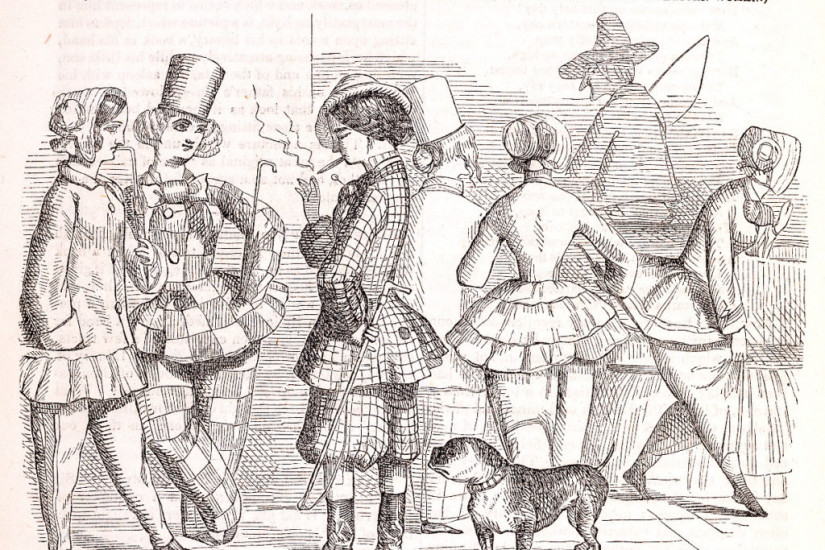Public calls for women’s rights prompted a backlash. Artists, editors, and publishers seized upon fears of political women and produced a powerful new wave of cartoons to caricature them. They policed gender roles and undercut reformers. In 1849, David Claypoole Johnston, a popular engraver based in Boston, published a page of five scenes in his periodical, Scraps. His cartoons exemplify the negative press that plagued activists. One picture on the top right, Women’s Tonsorial Rights, depicts a woman about to be shaved in a barbershop. To her right, a woman stands in an unladylike manner with her hands in her coat pockets and a cane propped against her chair. Another female customer reads the Woman’s Rights Advocate newspaper as she sits with her feet up on a chair. On the left, a woman shaves her face. The scene recalls pictures of barbershops filled with men, with their hats and canes set aside, socializing as they are shaved. Even the picture hanging on the wall depicts female boxers. Johnston’s other images reveal that these scandalous women might feel empowered to propose marriage and smoke in public. He suggested that women would become like men physically and usurp men’s separate spaces and rites if they gained rights.
Artists and editors presented the movement as a ridiculous threat to established values. Similar to Johnston, in August 1851, Harper’s New Monthly Magazine, aimed at an educated Northern audience, combined several of these sexist tropes into their engraving called Woman’s Emancipation. The illustration depicts six women wearing bloomer styles with top hats or bonnets, carrying canes, and smoking. The bloomers have short skirts, much shorter than those actually worn, and one woman on the right pulls up her pant leg, boldly revealing an ankle. Another woman on the left wears a bulky overcoat with her hands in her pocket in a relaxed, masculine stance. The only man in the picture wears a broad-brimmed hat and holds a whip, an allusion to true manhood. He turned his back to the women and rides away hauling a cart; perhaps he is a farmer who has just finished his dealings in town. He is leaving the city with its “emancipated” women for a more traditional rural community. Two of the women link arms, perhaps a suggestion of their preference for female partners, and watch him go.
An accompanying satirical letter underscores the idea that political women challenge values ranging from gender norms to heteronormativity. The letter, supposedly written by the “strong-minded American woman” Bostonian Theodosia Bang, declared that women were emancipating themselves from the “feudal” systems, symbolized by the term “Lady,” and from traditional “European” clothing. Bang continued, “The American female delivers lectures, edits newspapers, and similar organs of opinion” so that the “degrading cares of the household are comparatively unknown to our sex.” Emancipated women were distinctly American, and the fictional character announced that she planned to proclaim these ideas in Europe next.
Artists, editors, and publishers expected audiences to laugh at these women. Without context, to twenty-first-century eyes, pictures of women living nontraditional lives might suggest that Harper’s Weekly supported women’s rights. Today, Americans regularly see images of women smoking, wearing pants, and taking part in same-sex relationships. However, knowledge of the era’s visual context makes the ridicule apparent. Neither cartoon represents the reformers as respectable women. Scraps was a comic publication, and the satirical letter in Harper’s Weekly’s clarified the picture’s message. Women’s rights supporters were easy targets and subjects for entertainment since most Americans opposed their cause.

